This was published 10 months ago
‘Getting sick made me drop that ego’: The reinvention of Michael Klim
When the former Olympian was diagnosed with a debilitating disease, it rocked him to his core. After finding a path to acceptance, he now wants to help others reach a similar place.
By Luke Benedictus
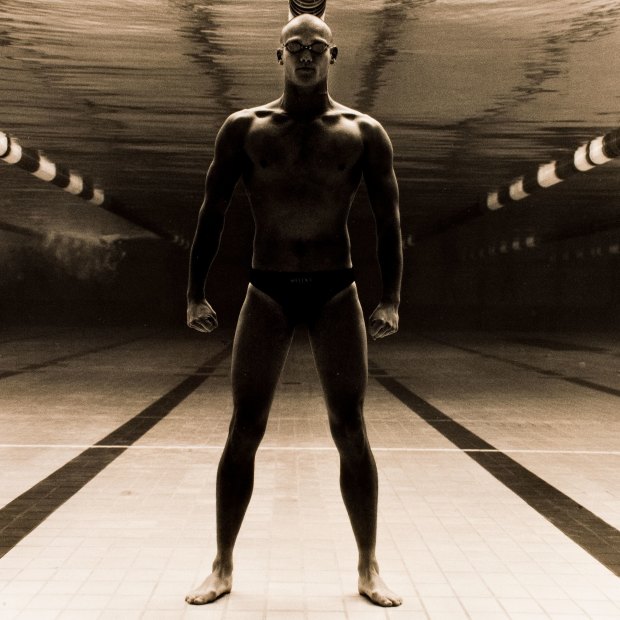
The 1999 portrait of Klim in the National Portrait Gallery. “I was kind of in my prime,” he says.Credit: National Portrait Gallery Collection. © Anderson & Low
The swimmer stands calmly on the bottom of the pool, dressed in Speedos. Behind the goggles, his face is as impassive as a Greek sculpture, his torso cast in heavy shadows that fail to obscure the rippling might of the shoulders and arms that taper into clenched fists. Black tile lines and lane dividers appear to shoot out of his body like laser beams, the composition forging an optical effect that makes the lanes stretch on forever. On a recent Saturday afternoon at the National Portrait Gallery in Canberra, it’s notable how people linger over this picture, drawn in by its heightened sense of reality. The subject looks like a superhero or sea god exuding vast strength and mythical power.
A couple of weeks later, I’m sitting with Michael Klim himself, upstairs at his parents’ modern home in the Melbourne suburb of Brighton. Hunched over my phone, we’re studying that picture, taken by the British fine art photographers Anderson & Low. Klim remembers the shoot well. How the picture was taken during a Speedo campaign at the Australian Institute of Sport; the way the photographers snapped it through an underwater window in a pool designed for coaches to monitor their charges. “It’s definitely one of my favourite photos,” says Klim, leaning back in his armchair next to a sideboard covered with old swimming trophies. “It was 1999, I was kind of in my prime, and everything was geared towards Sydney.”
“Sydney”, of course, refers to the 2000 Olympics, where Klim famously won gold medals in the 4x100 metres and 4x200 metres freestyle relays, plus silvers in the 100 metres butterfly and 4x100 metres medley relay. Today, he’s in a different physical space. The reason for his visit to Melbourne – the 47-year-old has lived in Bali since 2012 – is because he’s booked into hospital tomorrow for intravenous immunoglobulin therapy (IVIg), which involves a transfusion of purified blood plasma. It’s a four-hour procedure that he undergoes on two consecutive days. It’s become so routine that Klim now regards it as “a nice bit of downtime”, invariably spent on his phone checking up on his beloved AFL team, St Kilda.
He requires IVIg every six weeks, having been diagnosed in 2020 with a rare neurological disorder called chronic inflammatory demyelinating polyneuropathy, or CIDP. The autoimmune disease attacks the myelin sheaths protecting the nerves, causing progressive muscle weakness. Symptoms include loss of feeling and strength in the limbs, along with impaired balance that can make it difficult to walk. Without treatment, one in three CIDP sufferers ends up in a wheelchair, and there is no cure.
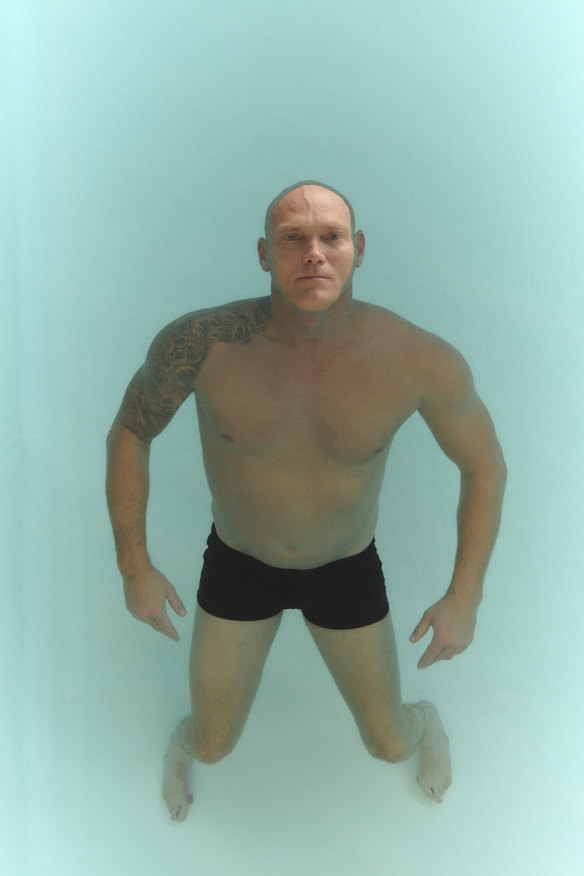
“I’ve literally got no muscle, really, from my knee down,” says Klim. “All this has just disappeared.”Credit: Josh Robenstone
Over the years, I’ve met Klim several times on the media roundabout, but had not seen him since his diagnosis. To be honest, I wasn’t sure what to expect, particularly given reports he could no longer walk unassisted. Yet first impressions are reassuring. On this June morning, Klim is cheerful and excited to discuss his new memoir, Klim, released by Hachette this month, in which he talks candidly about everything from his swimming career to his life-changing condition. The only sign of the latter is his heavy reliance on the banister as we climb the staircase. That aside, he’s still a physically imposing figure. Dressed all in black – Ksubi sweatshirt, cotton chinos, Nike sneakers – he’s casually stylish, with his sleekly bald head making him appear as clean-cut and strong-jawed as ever. In short, Klim looks good. When I mention that it’s great to see him looking so fit and strong, he laughs and rolls up his trouser legs. What he reveals is confronting.
Remember Consequences, the kids’ game where players take it in turns to draw heads, then bodies, then legs, folding the paper over each time before passing it to their neighbour? This feels like a real-life version. Klim’s legs look like they belong to someone else. Contrasting with the powerful heft of his upper body, his calves are now shockingly thin. Beneath his trainers and extending up the back of his lower legs are ankle-foot orthoses, carbon-fibre braces that help him walk. “I’ve literally got no muscle, really, from my knee down,” he says, frowning at his calves. “All this has just disappeared.”
It was six years ago when Klim first became aware of a strange numbness in his lower body. His feet often felt cold and he’d get this sciatic tingle “like hot water being poured down the back of my legs”. The symptoms mystified doctors. Like many former athletes, Klim was dealing with the troubled legacy of a life in professional sport, from a dodgy ankle that needed surgery to chronic back pain. While these issues were explored as contributing factors, his condition worsened. When specialists finally diagnosed him with CIDP, he could no longer walk without a cane.
While he’ll probably never run or surf again, exercise remains a necessity for Klim. But the emphasis is now on rehab to slow the loss of muscle function. At home in Bali, he endeavours to do some form of gentle movement each day, whether it’s going for a swim or a light gym session. Otherwise, he’ll take a short walk on the beach with his partner, Michelle Owen, a DJ/music producer/online gallery owner, who he met in a Bali beach club five years ago. At first, Klim was self-conscious on those walks. “It took me a while to comfortably walk down the beach with these sticks for my legs and not really care too much about what people would see or say.”
What makes Klim’s affliction so cruel is that physical athleticism has always defined his sense of self. Born in the Polish city of Gdynia, he and his older sister, Anna, had a peripatetic childhood. When Klim was still a baby, his father, Wojtek, was appointed Polish trade attaché to India. Together with his mother, Ewa, the family moved to Mumbai, where they lived for five years. Further moves followed until, in 1989, the family settled in the Melbourne suburb of Moorabbin and his parents set up a trading company exporting wool, consumer goods and household appliances back to Poland. Klim was 11 when they arrived in Australia but had already lived in Poland, India, Germany and Canada.
As a boy with a foreign accent trying to navigate these different cultures, Klim was painfully aware that he stood out, a fact not helped by a lisp that required speech therapy. “I wanted to be recognised for the right reasons,” he says. Having learnt to swim in Mumbai, the sport became his social currency. In each new country, Klim joined the local swimming club. “I always became ‘the swimmer guy’,” he recalls. “The pool was a consistent thing in my life no matter where I went. Swimming kept me on track and gave me structure. It helped me overcome my insecurities, my shyness and my lisp.”
By the age of 12, Klim was training twice a day at the Melbourne Vicentre Swimming Club, and the endless laps paid off. At the national junior championships in 1991, Klim broke the Australian 50 metres freestyle record for 13-year-olds. The following year, he repeated the achievement for the next age group. By 1993, Swimming Victoria was describing him as “probably Australia’s best junior talent”. Mazda even gave him a sponsored car with his name emblazoned on the side when he was still too young to drive.
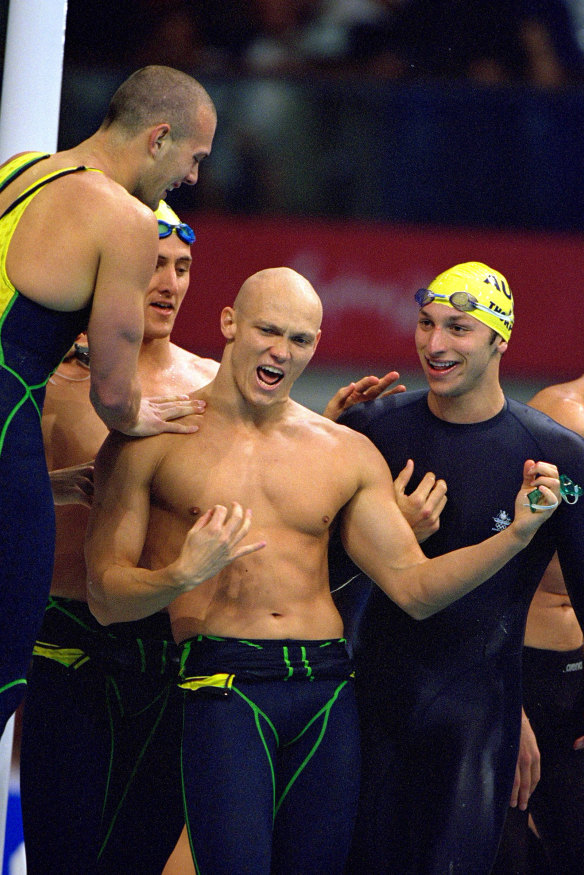
Klim with the Australian men’s 4x100m freestyle relay team after winning gold at the Sydney Olympics.Credit: Getty Images
“Everyone was talking about Michael as a potential superstar,” says Rob Woodhouse, a former Olympian, now CEO of Swimming Australia. After retiring from swimming in 1990, Woodhouse set up his own sports marketing agency, Elite Sports Properties, and Klim was one of the first athletes he signed. In 1997, the swimmer broke the 100 metres butterfly world record and stoked the growing hype at the world championships in Perth the following year, winning seven medals including four golds – two of them using the straight-armed freestyle technique his coach Gennadi Touretski had fostered. “Swimming got huge coverage back then and Michael was the most dominant athlete,” Woodhouse says. “He was a very hot property.”
The Australian Financial Review estimated Klim’s gross earnings for 1998 to be $1.1 million. The money poured in from sponsors as excitement for the Sydney Olympics grew. In Sydney the year before the Games, Klim remembers driving down William Street towards Kings Cross one evening when he noticed a familiar face on the billboard next to the Coke sign. “I thought, ‘That kind of looks a bit like me.’ And then, the closer I got, I realised it was my head on a billboard for Braun. It was surreal.”
That distinctive, bald head was everywhere. Klim was profiled by 60 Minutes and stuck on the cover of the nine million printed copies of the Official Olympic Games Ticket Book. The Sydney Morning Herald and The Age painted him in gold and put him on the front page. Evidence of how Klim’s celebrity now transcended his sporting prowess followed a training camp in Hawaii, where he was randomly photographed wearing a temporary tattoo on his shoulder of the Foo Fighters’ logo – a freebie included with the US band’s album. “Next thing I get a call from the Foo Fighters’ agent at Sony saying: ‘We want to put Michael on the album cover,’ ” Woodhouse recalls. Klim consequently appeared on the Australian edition of There Is Nothing Left to Lose.
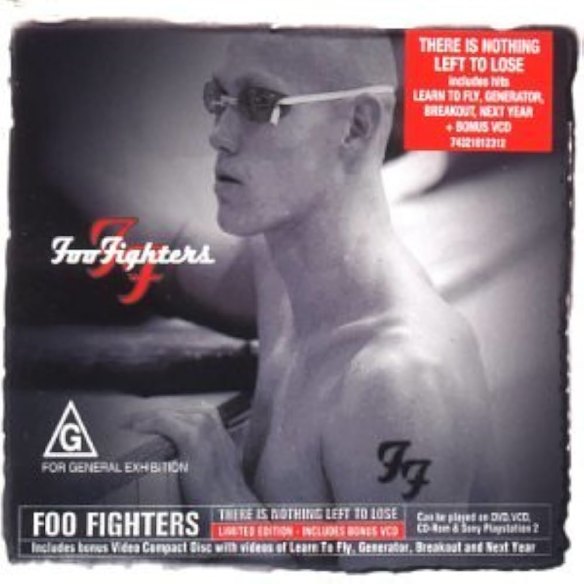
Klim on a Foo Fighters CD cover.
What did Klim put this rock-star status down to? “I don’t want to use the word ‘unique’,” he says, “but I obviously looked a little bit different.” There’s probably something in this. Klim began shaving his head in 1996 as an extension of removing his body hair to improve hydrodynamics, something elite swimmers routinely do. The result was striking, accentuating his high cheekbones and the wide plains of his face. Jonathan Anderson, the photographer who took the photo hanging in the National Portrait Gallery, recalls being disarmed by Klim’s otherworldly look. “The first time we worked together, I remember saying: ‘Michael, you are incredibly photogenic.’ He was quite chuffed and said, ‘Great, thanks!’ We said, ‘Yeah, Michael, we didn’t say ‘good looking’, we said ‘photogenic’ – it’s not the same thing at all,’ ” Anderson laughs. “But he’s got this arresting look that could be intimidating if he wasn’t such a lovely guy.”
Clive James was another to comment on the sense of power Klim embodied. In his 2001 collection of essays, Even As We Speak, James notes how the swimmer’s “mere appearance – shaven head, vulpine smile, the eyes of a cashiered SMERSH officer pledged to wreak vengeance with a stolen atomic bomb – can usually be relied on to drain the opposition’s will to live”.
Becoming one half of a celebrity It-couple amplified Klim’s visibility. In 2004, as the face of Myer menswear for the Spring Racing Carnival, he was paired with a model, Lindy Rama, to strut the catwalk at a Victoria Racing Club women’s lunch. The pair began dating. As well as being a statuesque beauty, Rama was Balinese royalty and the niece of the king of Denpasar. She’d lived in a palace in Bali until she was three, before moving to Tasmania with her Australian mother after her parents divorced.
Carrying echoes of some inverted fairytale, the relationship was irresistible to the media. Robyn Foyster, then editor-in-chief of New Idea and The Australian Women’s Weekly, didn’t hesitate to splash out for a New Idea cover story on their wedding at St Joan of Arc church, Brighton in 2006. “You had this sporting hero marrying a glamorous Balinese princess,” she recalls. “It captured the imagination of everyone.”
Having won six medals in three Olympics (two gold, three silver, one bronze), Klim hung up his togs in 2007 to make the transition from swimmer to entrepreneur. He and Lindy launched a skincare company called Milk, a name that projected cleanliness and purity but also spelt their surname backwards. Having spent years in chlorinated pools, Klim was used to slathering on moisturiser to combat dry skin. Milk & Co started off as a skincare line for men before expanding into women’s and baby products.
Most celebrity-driven products involve tokenistic input from the personality, but Klim was surprisingly hands-on. “Mike was heavily involved in everything from distribution meetings and product development to decisions about marketing and packaging,” says Nick Miller, the director of Milk & Co. By 2010, the brand was stocked in 3000 stores in Australia and 16 international markets.
Klim, meanwhile, was at full stretch, having decided, at the age of 33, to make a sporting comeback three years after retiring. “I still had those feelings of ‘What if?‘,” he says of his motivation. Between his business and swimming, Klim struggled to spread himself between his professional interests and his growing family which, by 2011, included three children: Stella, Rocco and Frankie. His attempt to qualify for the 2012 London Olympics was not successful, and he quit swimming for good. In a bid to find some life balance, he and Lindy headed to Bali. “We went over for an extended holiday with the family to, I guess, reconnect,” Klim remembers. The tropical lifestyle coupled with the affordability of domestic help for their frenetic family life meant Bali soon became their permanent home.
Logistically, this proved difficult for Klim, who still needed to attend board meetings and put in the face-time needed to do things such as plead with the head buyer of Chemist Warehouse not to discontinue stocking Milk. (“I think I was a control freak to a degree as well,” he concedes.) He began commuting between Melbourne and Bali, clocking up 25-plus return trips a year. “I tried to do it all,” he says. “There’s that glorified hustle in that corporate space. But they call it ‘burnout’ for a reason, and eventually something has to give.” In this case, it was the Klims’ marriage. The pair separated in 2016, but Klim continued to live in Bali and got a villa in nearby Berawa to ensure he could co-parent the kids on alternate weeks.
Looking back on the split, Klim accepts he was so driven at the time that he got the balance of his life wrong. The tunnel-vision focus that had served him so well in elite sport didn’t leave sufficient room for family life. “Sometimes I think that I prioritised my success and the company’s success,” he reflects now.
In the first act of Klim’s life, he was a celebrated sportsman. In act two, he became an entrepreneur. In 2020, CIDP systematically demolished those twin foundations of his identity. About 12 to 15 new cases of CIDP are recorded in Australia each year, with researchers still unclear on the underlying cause. Men are more likely than women to get the disease, but there’s no evidence that hardcore exercise increases susceptibility. Treatments like IVIg that suppress the body’s damaging autoimmune response to myelin can help to manage the condition in most cases, yet more than 50 per cent of sufferers need help to walk at some point and not all recover.
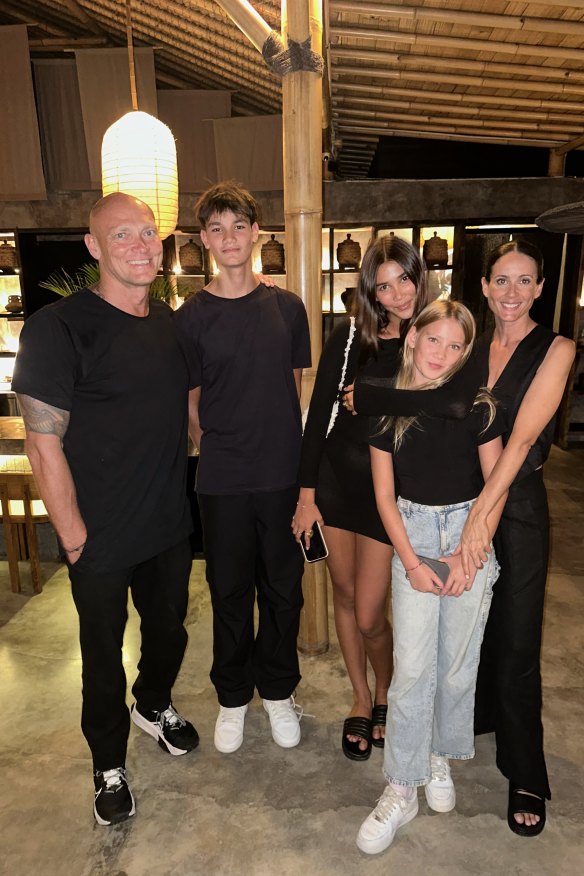
With (from left) children Rocco, Stella and Frankie and partner Michelle Owen.Credit: Courtesy of Michael Klim
Klim’s mobility was badly affected. He could no longer get around without crutches or a walking stick. He stopped cycling because he didn’t trust his legs or his balance. “I’d always put so much focus on my physicality and, when you remove that and start searching for validation, well, you’ve kind of lost everything. My self-worth just hit rock bottom.”
Compounding this was Klim’s belief that CIDP diminished his role as a father. He’d always loved being an active dad, shooting hoops with his son or playing tennis with his daughters. The kids had watched him surf huge waves. Sometimes Rocco would request he picked him up from school wearing a bicep-baring tank top, as his classmates thought Klim looked like Dwayne “The Rock” Johnson. “Now I couldn’t even go for a walk with the kids,” he says. Instead, he reached for their hand when attempting a staircase.
‘I wasn’t really equipped to deal with those emotions and I withdrew.’
Michael Klim
Soon he was unemployed, too. After their divorce, he and Lindy sold 90 per cent of Milk & Co to an Australian–Chinese syndicate called Aubrands in 2017. “It definitely helped our immediate future, but it wasn’t a retirement fund,” says Klim of the deal. He stayed on at Milk as a salaried general manager. But in February 2021, he received an unexpected email terminating his role in the brand he’d co-founded. Despite Klim having to threaten legal action to secure unpaid entitlements, he is philosophical about his dismissal, insisting he’d reconciled himself to ceding control following the company’s sale. “It was a surprise, but my emotions were consumed by my health issues.” Far harder to accept was that another cornerstone of his identity had been yanked away.
Always a conspicuous figure due to his hulking size, Klim grew self-conscious about being in public because of his unsteadiness on his feet. He became increasingly reclusive, barricading himself in the Bali villa he shared with his partner, Owen. During the day, he struggled to find the motivation to get out of bed. Never previously a big drinker, he started to self-medicate with alcohol; if Owen had a glass of wine, he’d finish the bottle. “There was grief for the loss of my identity, there was frustration and there was anger,” he says now, looking back. “I wasn’t really equipped to deal with those emotions and I withdrew.”
Klim credits Owen as the lifeline that stopped his descent. He sounds faintly incredulous that she stuck with what he calls “the dud version of Michael Klim” – a man who characterised himself as physically incapacitated, unemployed and mentally lost.
‘His mental state was very bad.’
Michael Klim’s father Wojtek
“He was definitely going through a bit of an identity crisis – as he would,” Owen tells me via phone from Bali. “I was just trying to remind him that, although we are not married, I do believe in ‘through sickness and in health’. I wanted to reassure him that we were in this together and that I wasn’t going anywhere. And that I’m not with him because he was ‘Michael Klim the swimmer’, or because he’s got great arms. It’s because he’s a really beautiful and generous and kind person. He always says that he identified with his strength and physique because he was that athlete. But I was like: ‘You’re so much more than that.’ ”
The turning point came in Easter 2022, when Klim’s parents visited the couple in Bali. Having not seen their son for months due to COVID-19-related travel restrictions, they were shocked by his condition. “His mental state was very bad,” says his father, Wojtek. “We were very, very scared something bad may happen, he was suicidal in my opinion. We never mentioned this to him and he never mentioned this to us. But I was scared.”
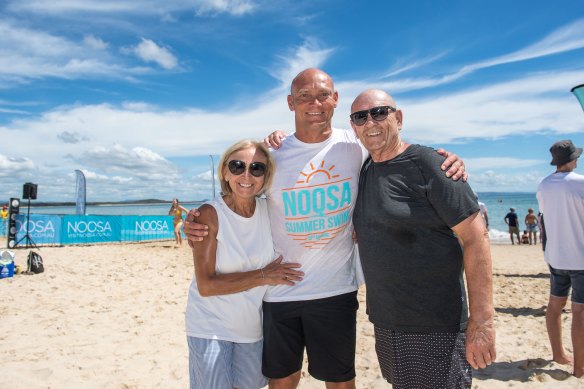
With his parents, Ewa and Wojtek.Credit: Courtesy of Michael Klim
Together with Owen, they sat their son down and staged what Klim describes as a “quiet intervention”, urging him to re-engage and take more responsibility with his treatment. To continue playing an active role in his children’s lives, they said, he needed to become more proactive with his mental health and self-care.
“That started a shift in my mindset,” Klim says. He began to manage his health with the same discipline and commitment he’d once applied to swimming. He gave up the booze that doctors had warned was bad for his condition. He lost weight after overhauling his nutrition and switching to an Atkins-style diet. He underwent counselling with Lyndel Abbott, a former Australian Olympic team psychologist, who recommended he dedicate one hour a day to his feelings of anger and grief before moving on with his life. Unable to surf, he got a paddle-board that he could kneel on.
Professionally, he returned to the pool in a different capacity. Back in 1997, he’d established Klim Swim, a learn-to-swim franchise business in Melbourne. Klim had only ever been the face of a firm that had been run by his parents and sister before fizzling out during COVID. Now, he brought Klim Swim to Finns Recreation Club in Bali and began to teach kids to swim and coach competitive swimming.
There was no overnight transformation, he stresses. “It was little things, bit by bit. But those things made a huge difference. In the last two years, my symptoms and mobility have only improved, I’d say, 5 to 10 per cent – not a great deal. But my outlook and my productivity have transformed 100 per cent. That’s shown me it’s not about my physical ability, it’s about how I approach life.”
‘I was still hanging on to a lot of ego from being a high-profile athlete.’
Michael Klim
In July 2022, Klim went public about his condition. As a knock-on effect he became the poster boy for CIDP, with a stream of sufferers contacting him to share their diagnoses and treatments. “I was getting one or two messages a day,” he says. Klim didn’t feel qualified to help beyond talking about his experience, but he understood why they were reaching out. Following his diagnosis, he’d struggled to find reliable information. “There isn’t enough out there,” he says.
Launching this month, the Klim Foundation aims to remedy that situation. Its goal is to become the go-to resource for CIDP sufferers and their families, providing support and information. Part of that extends to offering financial solutions for accessing treatment and services. CIDP is not recognised by the NDIS, so the foundation will enable sufferers to apply for money to afford the likes of hydrotherapy treatment or specialised orthoses. It’s a noble goal, even if Klim admits the financial structure is still evolving. He’s covered the basic set-up costs so far, while an initial funding phase requesting donations is about to roll out. The foundation requires about $200,000 to cover the initial overheads for therapy and equipment until the end of the 2025 financial year.
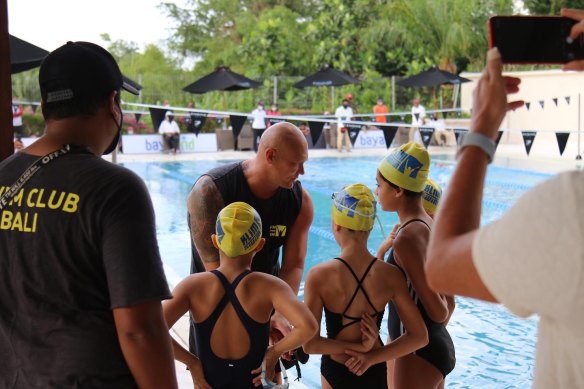
At work at his Klim Swim school in Bali, where he has lived since 2012.Credit: Courtesy of Michael Klim
Part of Klim’s motivation stemmed from something his health crisis forced him to recognise. “I was still hanging on to a lot of ego from being a high-profile athlete,” he admits. “Getting sick made me drop that ego … I think most of my life was all about receiving praise and taking adulation. It was all about me. Now it’s about trying to give something back.”
Klim’s domed head still appears on billboards. Except it’s now fronting campaigns for plasma donations, part of an ambassadorial role for Australian Red Cross Lifeblood that he took on last year. “I’ve had to redefine myself,” he says. “But that’s not a bad thing.”
‘Being an Olympian and a full-time athlete, for me, it was like an obsession. I don’t relate to that now.’
Michael Klim
The day after I visit Klim, Good Weekend’s photo shoot has to be cancelled because he isn’t well. It’s a reminder that, for all his renewed positivity, he’s still battling a debilitating condition. The next day, though, he’s able to make it along to the Melbourne Sports and Aquatic Centre in Albert Park, where he trained for so many years. Inside, we walk past a mounted board honouring Victoria’s Olympic swimmers. Klim’s name, of course, features prominently: 1996 (Atlanta), 2000 (Sydney) and 2004 (Athens).
It’s five weeks until the Paris games begin. How will he feel, watching the latest Australian swimmers compete? A mix of emotions is the answer. Sometimes it triggers another pang of regret that he never won an individual Olympic gold. There’s empathy for the swimmers too, because he understands what they’re going through. “But there’s also a sense of separation, because that’s a different life altogether,” he says. “Being an Olympian and a full-time athlete, for me, it was like an obsession. I don’t relate to that now.”
The day after the Olympic team was announced in June, Klim was invited to address the freshly minted swimmers at a Brisbane hotel. When he shows me the speech, one line jumps out, not so much for its motivational power as for the way it distils his newly enlightened mindset, one that prioritises relationships. “Success is nothing without the people who know you and without those who support you,” Klim told Ariarne Titmus, Kaylee McKeown, Cameron McEvoy and co. “You can’t buy support. It has tremendous value.”
On the top level of the Albert Park aquatic centre, the shoot is being set up around the hydrotherapy pool. Klim happily strips down to his swimwear as the photographer navigates the hard shadows and shifting reflections of the late-afternoon light. Over the years, Klim must have endured the creative whims of countless art directors in swimming pools. Yet he patiently stands in the water as the hours tick on, remaining chatty and engaged. In between shots, he occasionally steals a moment for himself, floating on his back with his eyes closed. Immersed in his favourite medium, he looks at peace. It’ll take more than a neurological disorder to sink Michael Klim.
To read more from Good Weekend magazine, visit our page at The Sydney Morning Herald, The Age and Brisbane Times.